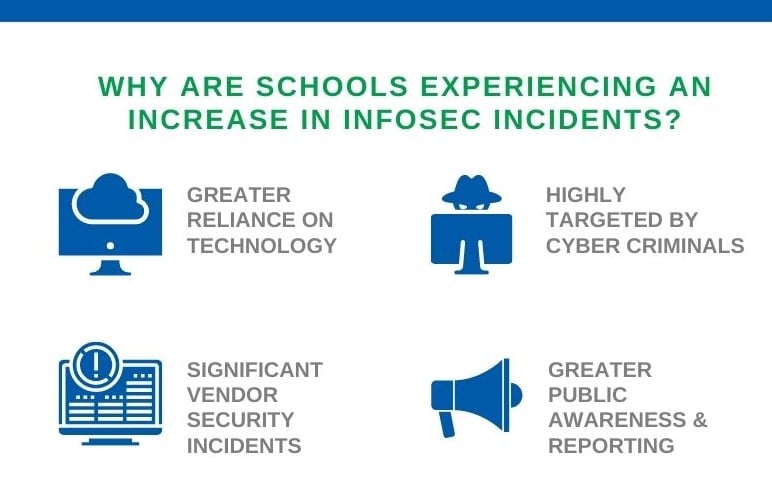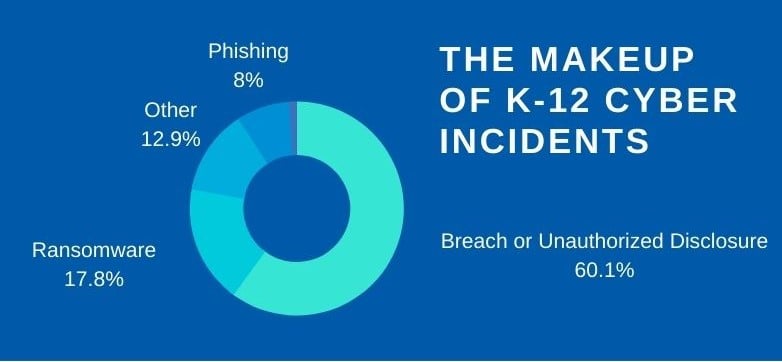In 2023, educational institutions faced a significant number of cyber security attacks. For instance, 80% of school IT professionals reported that their schools were hit by ransomware in the last year, which is an increase from 56% in the previous year.
Higher educational organizations reported being hit by ransomware at a rate of 79%, while 80% of lower educational organizations were targeted—an increase from 64% and 56% in 2021, respectively.
Additionally, the education and research sector experienced an average of 2,507 attacks per organization per week in Q1 of 2023, marking a 15% increase compared to Q1 2022. These statistics underscore the growing challenge of cyber security in the education sector.
These were the most common Cyber Threats in 2023 - here's how you can beat them!
Ensure Your Network’s Safety
Discover the benefits of our free security audits. Datalink Network's audits frequently reveal unnecessary or redundant services. Complete the form below!
Why is there an increase in Information Security Incidents?

In 2023, U.S. schools continued to be prime targets for ransomware, with the shift to digital platforms during the pandemic further heightening their appeal to cybercriminals. According to Sophos, 79% of higher educational organizations and 80% of lower educational organizations reported ransomware attacks—an increase from 64% and 56% in 20211. The education sector also faced an average of 2,507 attacks per organization per week in the first quarter of 2023, marking a 15% increase compared to the same period in 20222.
With the integration of technology into education becoming more entrenched, the need for cyber security training to address top threats has never been more pressing. Schools hold vast databases of confidential student and faculty information, making them lucrative targets for cybercriminals. Compliance with the Children’s Internet Protection Act is essential to safeguard this sensitive data.
Vendor security incidents have also been significant, highlighting the importance of establishing clear cyber security standards for school vendors and third-party practices. Breaches and unauthorized disclosures have been responsible for nearly 60% of K-12 cyber incidents.
As cyber threats evolve, so too must the public’s awareness and response. Cyber security awareness and reporting programs are now critical components of a school’s defense strategy, transcending mere compliance to become a cornerstone of network safety.
Stay safe with a trusted Managed Service Provider!
The Makeup of K-12 Cyber Incidents

In 2023, the escalation of cyber security incidents in schools highlighted the dire need for enhanced cyber security training and awareness among faculty, staff, and students. The spectrum of cyber threats targeting K-12 schools has expanded, ranging from common spam emails to sophisticated account takeovers. Schools must be vigilant against various threats:
Is your school safe from Cyber Threats? Read our article on how to stay safe!
-
Breach or Unauthorized Disclosure
Recent trends show a shift, with breaches often caused by external actors rather than insiders. However, vigilance towards current and former staff, as well as vendors with data access, remains crucial. -
Malware
This malicious software, designed to damage systems or gain unauthorized access, continues to spread via email attachments or malicious URLs. -
Ransomware
A particularly disruptive form of malware, ransomware encrypts user files and demands a ransom for their release. The impact on school systems can be devastating, both operationally and financially, with recovery costs soaring. -
Phishing
Fraudulent emails seeking sensitive information like network credentials remain a significant threat. Phishing may also involve malicious downloads and attachments.
K-12 Cyber Incidents in the News
Key takeaways
-
Comply with a recognized information security standard or framework- NIST, CSF, and ISO 27001 are well recognized among business and government agencies as best practices for cybersecurity management. School systems can certify for ISO compliance, which makes it easy to demonstrate a security posture to stakeholders. ISO also offers a 27701 certification for data privacy, which can help schools meet CCPA requirements.
-
Invest in information security compliance software - Software tools can take the complexity out of creating a robust security program, developing policies, and meeting ISO and NIST requirements. Orrios' Ontrack® is an easy-to-use, cost-effective platform that contains a complete policy library. Request a demo today.
-
Develop or update your security policies - With remote learning becoming the norm during Covid-19 it is critically important to have both a remote and on-campus security policy on hand. Check out our free checklist to see if your school is on track.
-
Frequently test your security program - Cyber security tests, such as security scans and penetration testing, should be performed frequently in order to check on any suspicious activity. With busy IT, it is important to have a knowledgeable managed service provider, like Datalink Networks, take care of these tasks. Chat with a representative today to discuss or schedule your free scan.
Schools can enhance their cybersecurity defenses and better protect against potential threats.
Conclusion
In 2023, cyber security incidents in education rose sharply, with 80% of schools reporting ransomware attacks. This calls for enhanced security measures and proactive defenses. Schools must focus on cyber security training, clearer policies, and regular network checks to combat threats like phishing and ransomware.
Keeping up with standards and updating security protocols are key to protecting educational networks in a dynamic cyber threat environment. Stay informed, stay vigilant, and take proactive steps to safeguard your school's digital assets. Remember, the safety of your network is paramount in an ever-evolving cyber landscape.
Stay connected with your trusted service provider, Datalink Networks, to navigate the complexities of cyber security and protect your educational institution from potential breaches. Stay safe, stay secure, and prioritize your school's cyber security today!




